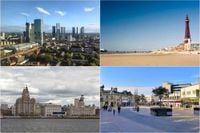England’s coastal towns and northern cities have once again found themselves at the heart of the country’s deprivation debate, as new government data paints a complex, sometimes surprising, and deeply human picture of hardship and resilience. The Ministry for Housing, Communities and Local Government’s (MHCLG) English Indices of Deprivation 2025, released on October 31, ranks every neighbourhood in England by a blend of factors—income, education, health, crime, housing, and environment—shedding light on both the scale and stubbornness of poverty in many regions.
Leading the list for the fourth time in a row is Jaywick, a small coastal village near Clacton-on-Sea in Essex. According to The Independent and Evening Standard, Jaywick’s Brooklands estate and Jaywick Sands promenade remain the country’s most deprived areas, a status it has held since 2010. The area’s struggles have become emblematic of the wider challenges facing many English communities, especially those on the coast.
Nigel Farage, the Reform Party leader and MP for Clacton since 2024, voiced his frustration to the PA news agency: "I’m obviously sad that things aren’t improving more quickly." Farage acknowledged his efforts to bring investment and tourism to the area but conceded, "there’s a limit to what one person can do." He added, "Everybody just feels very, very burdened these days." Farage also expressed concern that upcoming gambling reforms could further harm Jaywick’s economy, which relies in part on pier amusements and slot machines. As anti-poverty campaigners and some Labour MPs urge Chancellor Rachel Reeves to raise taxes on gambling firms to fund lifting the two-child benefit cap, Farage worries that "the situation might get worse."
Jaywick’s hardships have not gone unnoticed internationally. In 2018, the village was featured in a U.S. election campaign advert, its unpaved roads and dilapidated homes used as a warning of what could happen if voters failed to support Donald Trump. But local leaders insist the recent data doesn’t tell the whole story. Mark Stephenson, leader of Tendring District Council, praised the area’s "heart, pride and real community spirit," and said, "Together with local residents, we’ve made real progress and have a bold plan to go even further. But we cannot do this alone, we need Government to do its part." Stephenson called for £100 million in national flood funding and a cross-departmental taskforce to tackle policy barriers, stressing, "Jaywick Sands deserves a future that matches its spirit."
While Jaywick stands as an outlier, Blackpool’s story is one of persistent, widespread deprivation. The MHCLG’s latest figures, cited by The Blackpool Gazette, reveal that 70% of England’s most deprived neighbourhoods are in Blackpool. Seven of the ten most deprived areas nationally are found there, and 40% of its neighbourhoods rank among the country’s most deprived. This pattern has remained unchanged since 2010, highlighting what Minister for Local Government and Homelessness Alison McGovern described as "an indictment of previous policies." She insisted, however, that "the government is tackling the root causes of deprivation head on." The data, based on weighted metrics like income, crime, and barriers to housing, shows that 82% of the most deprived areas in 2025 were already in that category in 2019—underscoring the tenacity of these problems.
Other northern cities and towns also feature prominently in the deprivation rankings. According to Lancashire Post, Manchester, Burnley, Knowsley, Blackburn with Darwen, Oldham, Liverpool, Pendle, Hyndburn, and Halton all have between 31% and 41% of their neighbourhoods among the 10% most deprived in England. Middlesbrough, Birmingham, Hartlepool, and Kingston-upon-Hull also have high concentrations of deprivation. In fact, Middlesbrough has the highest proportion of very deprived neighbourhoods, with Birmingham and Hartlepool close behind.
The capital is not immune, either. The MHCLG notes that London boroughs such as Tower Hamlets and Hackney have the highest rates of income deprivation affecting children, while Newham, Islington, and Southwark are among the worst for older people. These pockets of poverty, often hidden among the city’s affluence, remind policymakers that deprivation is not solely a northern or coastal issue.
Yet, while government data can seem bleak, it doesn’t always reflect the lived experience of residents. In Hastings, East Sussex—ranked the 14th most deprived local authority in England—Barry Ashley runs the Grumpy Cook, a not-for-profit café where people pay what they can afford or eat for free, maintaining their dignity in hard times. "The place is on its knees," Ashley told the BBC, pointing to boarded-up shops and children without proper clothing. He blames austerity policies for slashing public services and local budgets, saying, "People feel forgotten." Still, he’s quick to praise the community’s "fantastic" spirit: "When people get together, they are strong and resilient. There’s no choice but to be."
Other Hastings residents challenge the deprivation narrative. Jordan Walid, who grew up in the town, told the BBC, "It has been a smooth ride," and insisted that "community spirit is alive in Hastings. Everyone likes each other. It is a friendly place." Lucy Brett echoed his surprise at the data, saying, "I would not have thought it’s that bad." Yasmin Ibison of the Joseph Rowntree Foundation explained that high deprivation in Hastings stems from "a combination of unemployment, housing costs, low incomes and poor transport infrastructure," compounded by changing holiday habits that have hit coastal economies. She warned that deprivation "can profoundly impact many aspects of people’s lives," leading to social and political disconnection, but she also highlighted "fantastic community initiatives and organisations doing amazing work" in Hastings. "Part of how we tackle some of the challenges of living in deprived areas is about involving communities in decisions and listening to their needs," Ibison said, emphasizing the importance of agency, ownership, and pride.
Not everyone is optimistic. Darren Cripps, another Hastings resident, lamented, "The town has a lot of potential, but no one seems to do anything with it. Things could be a lot better." The area northeast of Hastings, nestled between St Helen’s and Ore, is now ranked as the seventh most deprived in England.
Despite the grim statistics, the data is not destiny. As the MHCLG and local leaders agree, the scale of the challenge is immense, but not insurmountable. As Mark Stephenson put it, "Jaywick Sands deserves a future that matches its spirit," and, across England, communities are working—often against the odds—to make that vision a reality.






